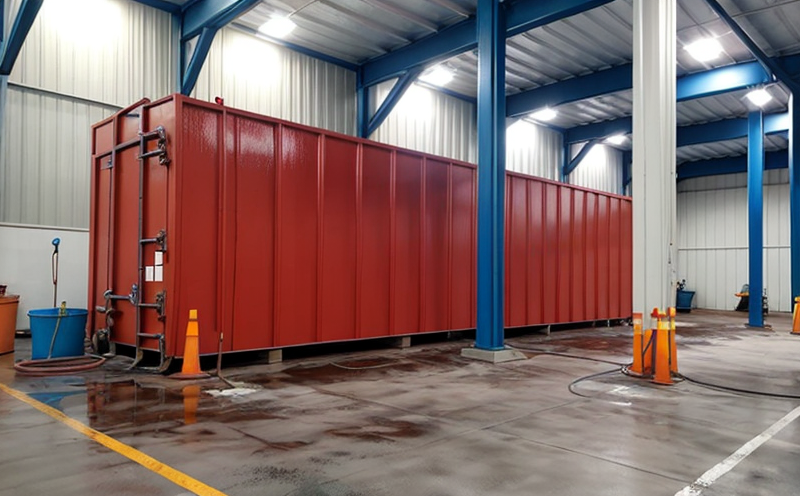ASTM G85 Modified Salt Fog Corrosion Testing of Coatings
The ASTM G85 modified salt fog testing method is a standardized procedure designed to evaluate the resistance of coatings, paints, and other surface treatments against corrosive environments. This test is crucial for industrial manufacturing and processing sectors, especially where long-term durability in harsh conditions is paramount.
ASTM G85 differs from conventional salt fog tests by incorporating a modified atmosphere that more closely simulates real-world conditions encountered during industrial operations. This includes increased humidity levels and the addition of other corrosive elements like chloride ions, which are present in industrial atmospheres. The test provides a comprehensive evaluation of coating performance under accelerated aging conditions.
The test involves exposing coated specimens to a controlled environment that mimics the atmospheric conditions found in industrial environments. Specimens are typically placed in a chamber where they are subjected to salt fog for an extended period, often up to 1000 hours or more. During this time, the integrity of the coating is monitored by visual inspection and measurement of any corrosion or degradation.
The test apparatus used includes specialized chambers that maintain precise temperature and humidity levels, ensuring accurate simulation of industrial conditions. The specimens are carefully prepared according to ASTM G85 guidelines, which include specific surface cleaning procedures and application methods to ensure consistent results. The testing process is closely monitored by experienced technicians who adhere strictly to the standard’s requirements.
ASTM G85 is widely recognized for its ability to provide reliable data on coating performance under severe corrosive conditions. This method ensures that industrial coatings meet stringent quality standards, thereby enhancing product reliability and extending service life in challenging environments. The test results are crucial for R&D engineers, quality managers, and compliance officers working within the industrial manufacturing sector.
Understanding the importance of ASTM G85 testing is essential for industries dealing with corrosive atmospheres. By conducting this test, manufacturers can ensure that their coatings meet or exceed international standards, thereby reducing maintenance costs and extending equipment life. This not only enhances operational efficiency but also contributes to environmental sustainability by minimizing waste and resource consumption.
The test results are typically reported in a detailed manner, highlighting the resistance of the coating to corrosion under specific conditions. These reports serve as valuable tools for decision-making processes within R&D departments and procurement teams. They help identify areas requiring improvement and provide insights into material selection for future product development cycles.
Why It Matters
The importance of ASTM G85 modified salt fog testing cannot be overstated, especially in sectors where the performance of industrial coatings is critical to operational success. In industries such as aerospace, automotive, and oil & gas, where equipment operates under extreme conditions, ensuring coating integrity is vital for preventing costly downtime and potential safety hazards.
By conducting ASTM G85 testing, manufacturers can verify that their products meet or exceed industry standards, thus gaining a competitive edge in the market. This test also aids in compliance with regulatory requirements, ensuring that all products sold meet specific quality benchmarks. For R&D teams, this testing process provides valuable data on material performance under various conditions, facilitating iterative improvements and innovations.
Moreover, ASTM G85 testing helps manufacturers understand the lifecycle of their coatings, enabling them to optimize production processes and extend product longevity. This not only reduces operational costs but also contributes positively to environmental sustainability by minimizing waste generation and resource consumption.
Benefits
- Enhanced Product Reliability: ASTM G85 testing ensures that industrial coatings can withstand harsh corrosive environments, leading to increased product reliability and extended service life.
- Compliance with International Standards: By adhering to this standard, manufacturers ensure their products meet or exceed international quality benchmarks, facilitating smoother market entry and compliance.
- Data-Driven Decision Making: Comprehensive testing provides valuable data on material performance under various conditions, aiding in informed decision-making processes within R&D teams.
- Cost Efficiency: Early identification of issues through rigorous testing can significantly reduce maintenance costs and downtime, resulting in overall cost savings for the organization.
- Sustainability: By extending product longevity and minimizing waste generation, ASTM G85 testing contributes positively to environmental sustainability efforts within industrial manufacturing sectors.
Use Cases and Application Examples
- Aerospace Industry: Ensuring that aircraft components are protected against corrosion in humid environments is critical for safety. ASTM G85 testing helps manufacturers meet stringent quality standards, ensuring the longevity of aircraft parts.
- Automotive Sector: Coatings used on automotive exteriors and interiors must withstand harsh environmental conditions. This test ensures that these coatings can endure real-world usage without degradation.
- Oil & Gas Industry: Pipelines and equipment in offshore platforms are exposed to corrosive atmospheres, requiring robust coatings for protection. ASTM G85 testing is essential for assessing the durability of these protective layers.
- Construction Materials: Coatings used on construction materials like steel beams and concrete need to withstand salt-laden environments. This test helps ensure that such coatings perform effectively in challenging conditions.





